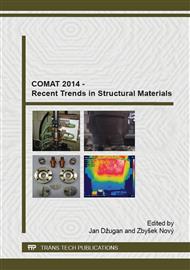p.1
p.9
p.17
p.23
p.31
p.39
p.49
p.55
Combination of International High Pressure Forming and Q-P Process for Production of Hollow Products from Ahs Steel
Abstract:
All sectors of industry experience high demand for shaped products with as good mechanical properties as possible at low costs. Automotive industry, in addition, requires that the parts are of lightweight construction. Consequently, new types of materials and processes have to be combined to design new production chains capable to meet this demand. For instance, there are high-strength low-alloyed steels, whose final properties are attained by advanced heat treating techniques. One of such techniques is the Q&P process which can deliver excellent ultimate strengths exceeding 2000 MPa at a sufficient elongation level of 10 %. When combined with an unconventional forming method, it allows complex-shaped parts with outstanding mechanical properties to be made. One example of such combined procedure is the sequence of internal high pressure forming, hot stamping and Q&P processing. In the present study, thin-walled hollow stock was processed using such a combined procedure. After stepwise optimization of processing parameters, products with martensitic structure and a small amount of bainite were obtained. In all locations of the product which were tested, the ultimate strength exceeded 1950 MPa and elongation reached 15 %
Info:
Periodical:
Pages:
9-15
Citation:
Online since:
October 2015
Authors:
Keywords:
Price:
Сopyright:
© 2015 Trans Tech Publications Ltd. All Rights Reserved
Share:
Citation:


